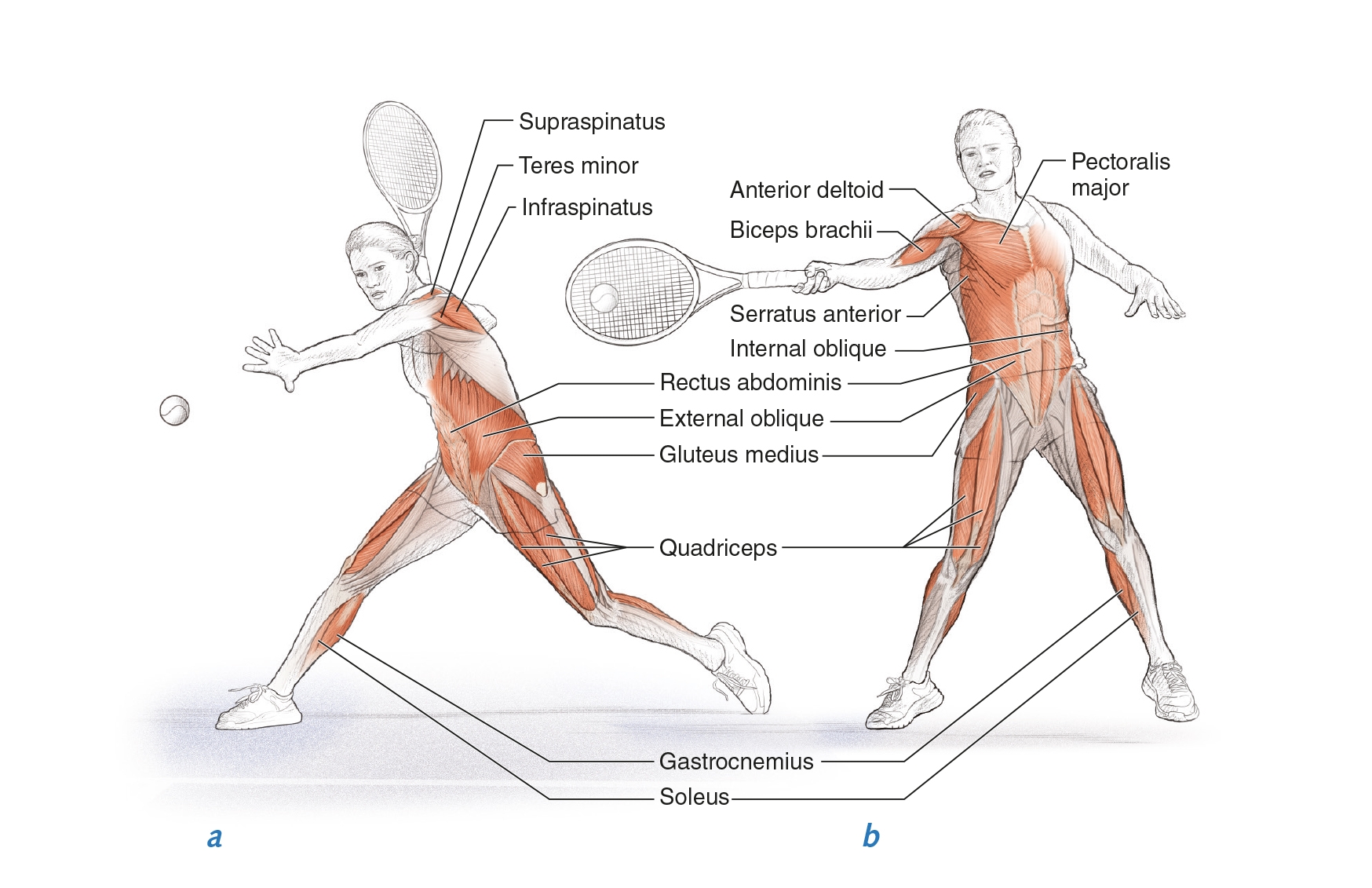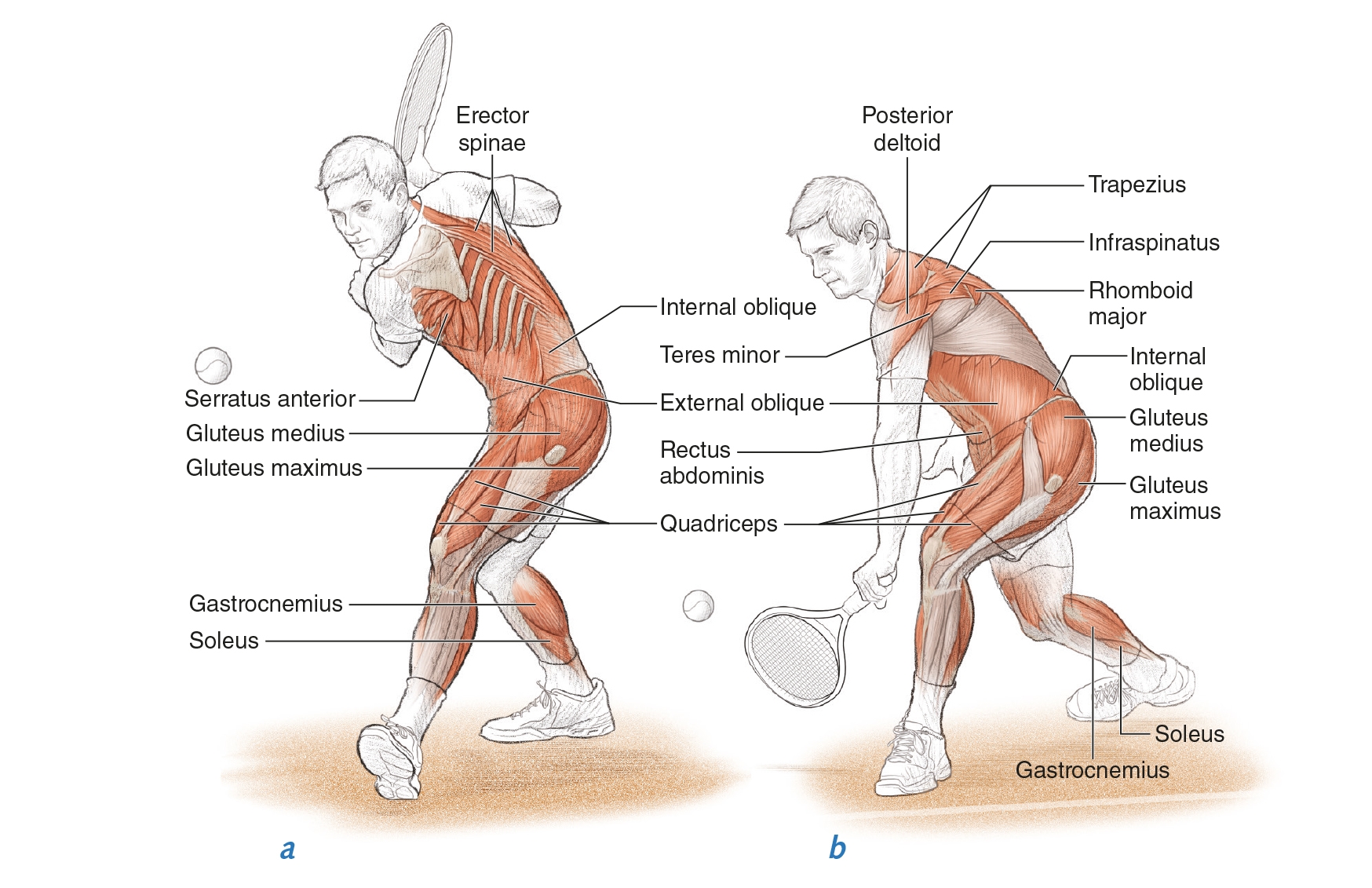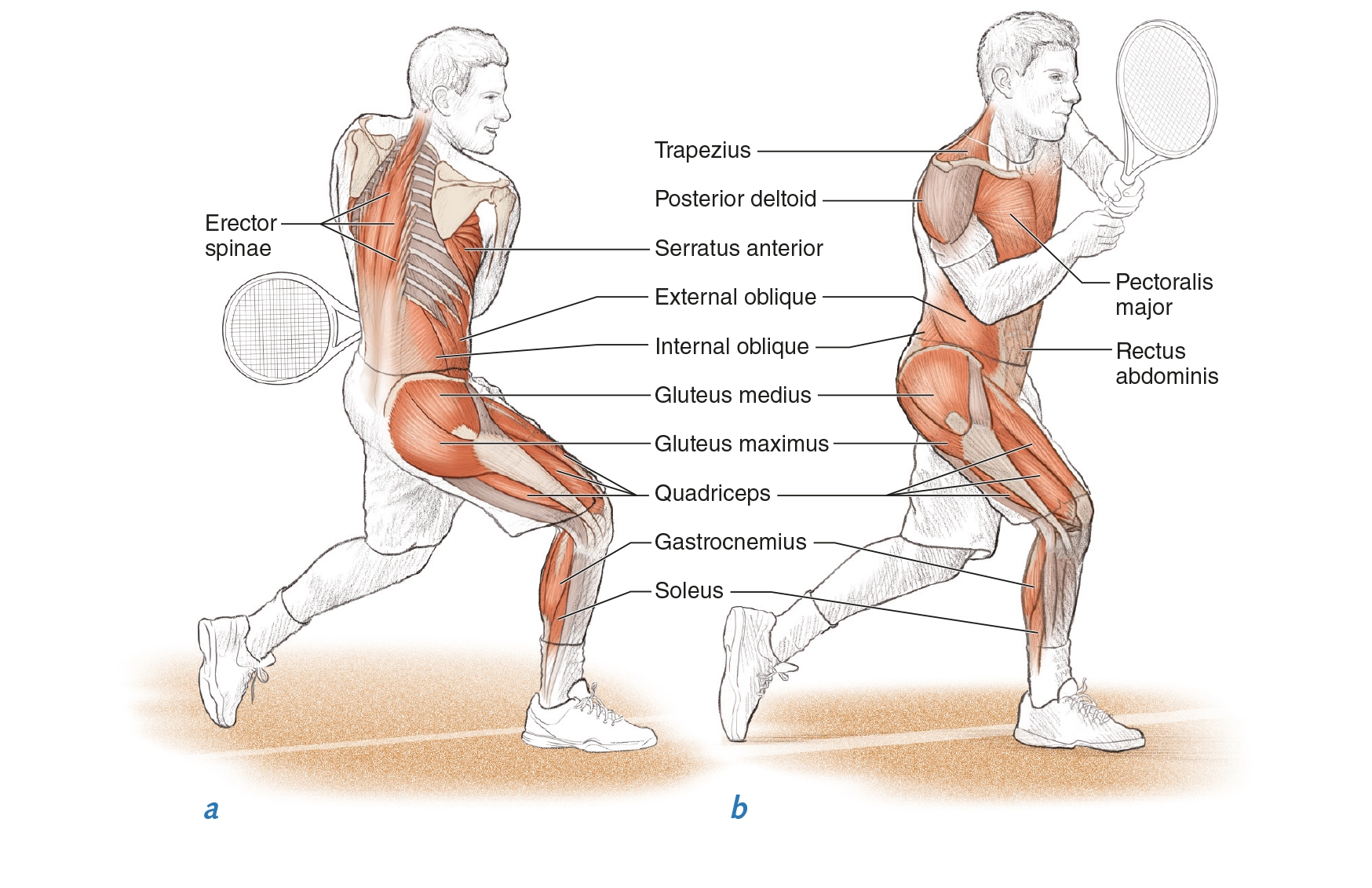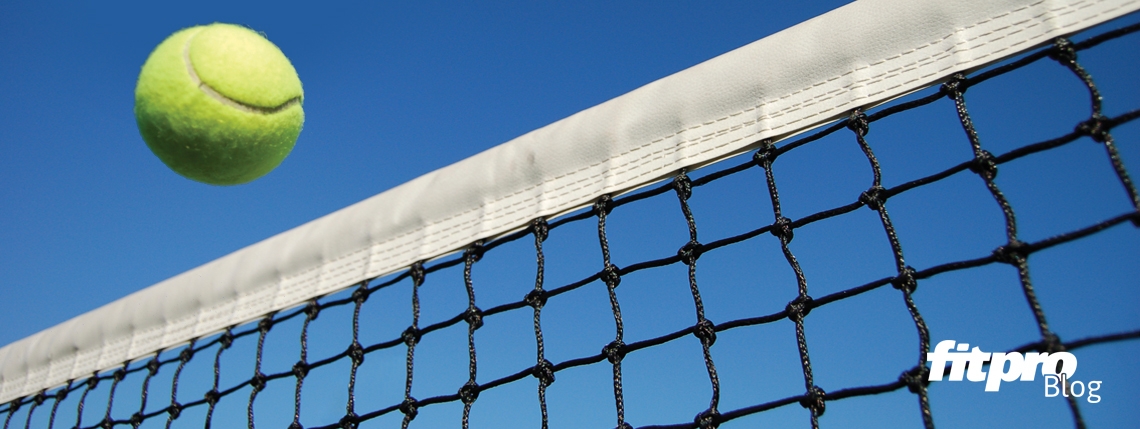This technical feature from Human Kinetics explains the major strokes and how action, muscles and muscle contractions are interrelated to produce effective and powerful stokes. Authors E. Paul Roetert and Mark S. Kovacs explain more as we approach the Wimbledon tennis 2018 final this weekend…
Forehand and backhand groundstrokes
Over the past 30 years, the greatest changes in tennis have likely occurred because of changes in racket technology. Rackets are made out of a variety of materials and are wider and stiffer, featuring a larger sweet spot. This has had a tremendous impact on the game, nowhere more than in the groundstrokes. The larger sweet spot is more forgiving on off-centre hits, and the racket materials allow for more forceful swings. Because of these changes, forehand and backhand swings have changed as well. The long, flowing swings and follow-throughs in the direction of the target have given way to more violent, rotational swings that end up across the body in a variety of positions depending on the type of shot. These swing patterns allow players to hit the ball from a more open stance, particularly when hitting forehands, but also when hitting two-handed backhands. This rotational component can put a significant amount of stress on the midsection. Therefore, exercises preparing the body for these stresses are vitally important.
Many of the muscle actions in the lower body are similar for all of the tennis strokes. There is an interplay between eccentric (lengthening) and concentric (shortening) actions that allows the body to store and release energy based on the phase of each stroke. In addition, each stroke requires trunk rotation, more so for ground strokes, serves and overheads than for volleys. The forehand, serve and overhead strokes differ from one- and two-handed backhand strokes in that the upper body muscles are activated in the opposite way. The muscles in the upper back and back of the shoulder act concentrically (shorten) in the loading phase and eccentrically (lengthen) in the follow-through. The muscles of the chest and front of the shoulder first contract eccentrically during the backswing and then concentrically during the forward swing. The backhand swing follows an opposite pattern.
Forehand groundstroke
The forehand groundstroke may be hit from an open stance, a square stance or a closed stance. Each body position requires different lower- and upper-body mechanics, although all three stances use a combination of angular and linear momentum to power the stroke. Linear momentum is a product of both mass and velocity and can be generated in both a vertical and horizontal direction. Angular momentum refers to the rotational component of the stroke and takes into account both the moment of inertia about an axis (resistance to rotation about that axis) and the angular velocity about that axis. Both linear and angular momentum are fundamental for the successful generation of power in the forehand. The amount of linear momentum created affects the amount of rotational force that is generated about each of the body segments.
The open-stance forehand (Figure 1.5) results in the greatest total-body rotation and requires greater strength and flexibility throughout the core and lower body than the square-stance or closed-stance forehand. The square- and closed-stance forehands require less rotation at the core, and ball contact is made more in front of the player and closer to the net. It is important to understand that each of the stances is situation specific. In other words, where you are on the court, the type of ball coming at you (both speed and spin), and the shot you are trying to hit often affect your stance.

Figure 1.5 Open- stance forehand (a) backswing (b) forward swing
During the backswing of the forehand groundstroke (Figure 1.5a), the gastrocnemius, soleus, quadriceps, gluteals and hip rotators contract eccentrically to load the lower legs and begin the hip rotation. The concentric contractions of the trunk rotation phase involve the ipsilateral internal oblique and contralateral external oblique, while the eccentric contractions pull in the contralateral internal oblique, ipsilateral external oblique, abdominals and erector spinae. The concentric contractions of the shoulder and upper arm rotation in the transverse plane are performed by the middle and posterior deltoid, latissimus dorsi, infraspinatus and teres minor, and are followed by contractions of the wrist extensors. The eccentric contractions of the shoulder and upper arm rotation in the transverse plane are performed by the anterior deltoid, pectoralis major and subscapularis.
During the forward swing (Figure 1.5b), the gastrocnemius, soleus, quadriceps, gluteals and hip rotators contract both concentrically and eccentrically to drive the lower body and hip rotation. Concentric and eccentric contractions of the obliques, back extensors and erector spinae cause the trunk to rotate. The latissimus dorsi, anterior deltoid, subscapularis, biceps and pectoralis major all contract concentrically during the acceleration phase to bring the racket to the ball for contact.
During the follow-through, the upper arm movement decelerates through the eccentric contractions of the infraspinatus, teres minor, posterior deltoid, rhomboids, serratus anterior, trapezius, triceps and wrist extensors.
One-handed backhand groundstroke
The one-handed backhand (Figure 1.6) involves the summation of forces similar to the forehand, but there are important differences as well. The strength and muscular endurance of the wrist extensors are important for successful repeated performance of the backhand. Research has shown that torque at the wrist can create a rapid stretch of the wrist extensors, especially in players who have a history of tennis elbow (lateral epicondylitis).

Figure 1.6 One handed backhand: a) backswing b) forward swing
For a one-handed backhand, the dominant shoulder is in front of the body. Typically, the stroke uses less trunk rotation; however, it requires a more co-ordinated action of the different body segments, including shoulder and forearm rotation, than the two-handed backhand. The front leg is more involved during a one-handed backhand than during a two-handed backhand. Similar racket speeds can be achieved with one- and two-handed backhands. Strength and flexibility, particularly of the muscles of the upper back and back of the shoulders, are key. Perform training exercises bilaterally to achieve muscular balance.
During the backswing of the one-handed backhand (Figure 1.6a), the gastrocnemius, soleus, quadriceps, gluteals and hip rotators contract eccentrically to load the legs and begin the hip rotation. The concentric contractions of the ipsilateral internal oblique and the contralateral external oblique are balanced by the eccentric contractions of the contralateral internal oblique, ipsilateral external oblique, abdominals and erector spinae to rotate the trunk. The anterior deltoid, pectoralis major, subscapularis and wrist extensors contract concentrically to rotate the shoulder and upper arm through the transverse plane as the posterior deltoid, infraspinatus, teres minor, trapezius, rhomboids and serratus anterior contract eccentrically.
During the forward swing (Figure 1.6b), the lower body and hip rotation is driven by the concentric and eccentric contractions of the gastrocnemius, soleus, quadriceps, gluteals and hip rotators. Concentric and eccentric contractions of the obliques, back extensors and erector spinae cause the trunk to rotate into the shot. The acceleration phase of the upper arm is performed through concentric contractions of the infraspinatus, teres minor, posterior deltoid and trapezius.
During the follow-through, the subscapularis, pectoralis major, biceps and wrist flexors contract eccentrically to decelerate the upper arm.
Two-handed backhand groundstroke
Many players benefit from the two-handed backhand (Figure 1.7), especially in the early learning stages. Both arms are used, increasing the power of the stroke, and fewer body segments are involved, which helps learning players co-ordinate the movement. These benefits help players hit balls in the strike zone and balls that bounce higher that must be hit above shoulder level. Although the two-handed backhand uses many of the same muscle groups as the one-handed backhand, the two-handed backhand requires greater trunk rotation. Therefore, the muscles of the torso and mid-section should be well trained, especially the internal and external obliques. This is especially important in open-stance backhands, which are becoming more prevalent at all levels of the game. In addition, the legs should be trained to provide a stable base of support, to properly transfer the forces from the ground to the racket, and to provide endurance for long matches. One area unique to the two-handed backhand is the use of the non-dominant arm and wrist. The flexors and extensors of the non-dominant forearm and wrist, and the muscles involved in ulnar and radial deviation, must be trained appropriately.

Figure 1.7 Two-handed backhand: (a) backswing (b) forward swing
During the backswing (Figure 1.7a), the eccentric contractions of the gastrocnemius, soleus, quadriceps, gluteals and hip rotators load the legs and begin the hip rotation. Concentric contractions of the ipsilateral internal oblique and contralateral external oblique are aided by eccentric contractions of the contralateral internal oblique, ipsilateral external oblique, abdominals and erector spinae. The shoulder and upper arm on the dominant side rotate through the transverse plane through concentric contractions of the anterior deltoid, pectoralis major, subscapularis and wrist extensors, and eccentric contractions of the posterior deltoid, infraspinatus, teres minor, trapezius, rhomboids and serratus anterior. On the non-dominant side, concentric contractions of the middle and posterior deltoid, latissimus dorsi, infraspinatus, teres minor and wrist extensors create the rotation of the shoulder and upper arm, assisted by eccentric contractions of the anterior deltoid, pectoralis major and subscapularis.
During the forward swing (Figure 1.7b), concentric and eccentric contractions of the gastrocnemius, soleus, quadriceps, gluteals and hip rotators drive the lower body and hip rotation. Concentric and eccentric contractions of the obliques, back extensors and erector spinae rotate the trunk. The upper arm on the dominant side moves to the ball through concentric contractions of the infraspinatus, teres minor, posterior deltoid and trapezius. On the non-dominant side, concentric contractions of the anterior deltoid, subscapularis, biceps, serratus anterior and pectoralis major bring the arm to the ball.
During the follow-through, the dominant arm decelerates through eccentric contractions of the subscapularis, pectoralis major and wrist flexors. The non-dominant arm decelerates through eccentric contractions of the infraspinatus, teres minor, posterior deltoid, rhomboids, serratus anterior, trapezius, triceps and wrist extensors.
The above article is an extract from Tennis Anatomy by E. Paul Roetert and Marks S. Kovacs by Human Kinetics and reproduced with permission. For a FitPro discount code, use code: FP25 at humankinetics.com
Where next? Explore another technical piece from Human Kinetics HERE







